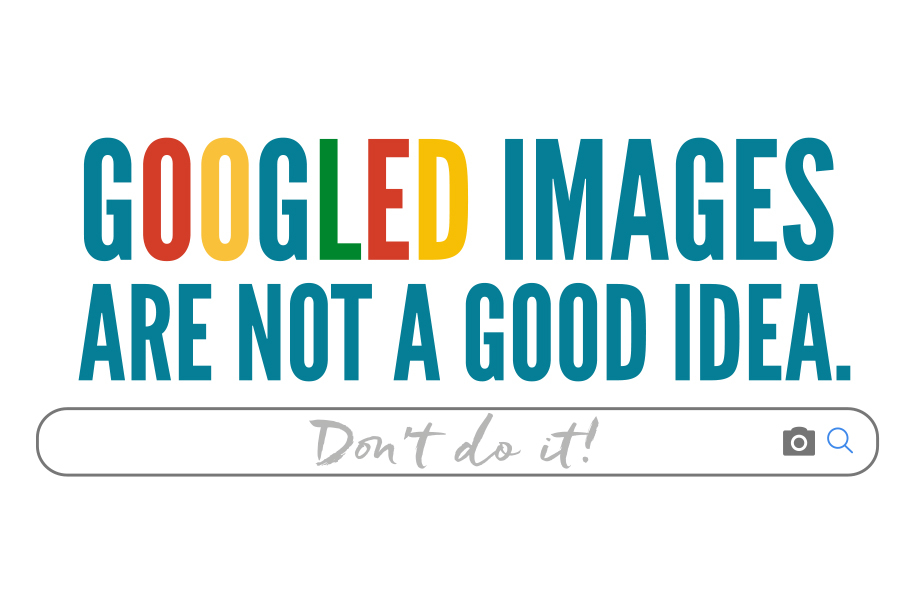Just because it’s on the internet doesn’t mean it’s free or worth using.
I do a lot of print work. And for larger projects such as event programs, I am frequently provided images that clients have pulled from the internet. These photos are rarely usable, either due to copyright issues or image quality. Here’s why.
Let’s talk legal stuff first. Image copyrights are important. Really important. Copyright law can be a bit confusing, but in general, any original image is protected by copyright—the creator of that image is the owner, and only they have the right to sell, copy, distribute or reproduce that image. That means if you didn’t create it, you can’t use it without permission.
As some people know, a quick Google search on any topic will result in thousands of images of all kinds, and it’s pretty easy to download most of them. But that doesn’t tell you whether or not it’s legal to use it. It’s safest to assume that everything is copyrighted, and then do a little research from there to find out the actual status.
What to do instead?
· Get permission (don’t assume unlimited use). If you find an image you want to use, contact the owner and ask for permission to use it. Be specific about what you want to use it for, and for how long. Better yet, when you start your search, look for Creative Commons images, which have built-in levels of permission. Just be sure you credit the owner properly.
· Purchase stock photography. There are tons of great stock photography sites out there that cater to every level of budget and style, including some offering free, high-quality photos. Once you’ve paid for it (or gotten a free download), you can use it. Be sure to follow any usage guidelines though—typical rights-managed photos can only be used for certain purposes or need a license for every usage (one for web, one for the invitation, one for the program, etc.)
· Take your own photos. The easiest way to know whether or not a photo is safe to use? Take one yourself! This option is really only recommended if you have a good camera and have experience in photography. A blurry iphone image won’t do you any favors and will look worse than not using an image at all.
Now that you have permission to use that image, let’s talk about production. Images for web and print are two different beasts.
What Size Should Images Be for Web and Print?
Web images are low-resolution and only require a resolution of 72 dpi (dots per inch) to look great on your screen. Print images need a resolution of 300dpi at full size to look nice and crisp. If you pull an image from the web, and print it out, you’ll see that it gets blurry and pixelated, which looks bad (and reflects poorly on the organization using it).
What to do instead?
· Purchase larger images. Most images on stock photography sites come in various sizes, from small, low-resolution images for websites up to XXL high-resolution files for printing. In general, it’s best to purchase the largest size image you can—it’s a lot easier to scale an image down than to make it bigger. If your budget doesn’t allow for the largest size, then get the size that most closely fits your needs.
· Search online for larger versions. If you’re provided an image that’s safe to use but low-resolution or too small for your needs, do a reverse Google image lookup and see if there’s a higher-resolution version of the image online. I typically find that this works, especially when it comes to speaker photos for conference guides. Or simply ask the provider of the photo for a larger version.
· Enlarge the image manually. Worst case scenario, if you have an image that you really want to use (and have permission) but is too small, you can try to enlarge it manually. Doing it well requires Photoshop expertise and a little bit of magic, so it’s best left to a design professional. Done poorly, your lovely image will get blurry and look awful.
Make Your Projects Picture-Perfect
If you’re short on time and need someone to source copyrighted images for your upcoming projects, then reach out to Weiher Creative. Our team specializes in all the complicated design tweaks and trends to make your images look clear and compelling. Plus, working with a graphic designer is good for your work-life balance.
And if you’re curious about working with a graphic designer, be sure to check out the latest 9 Reasons to Hire a Graphic Designer.
